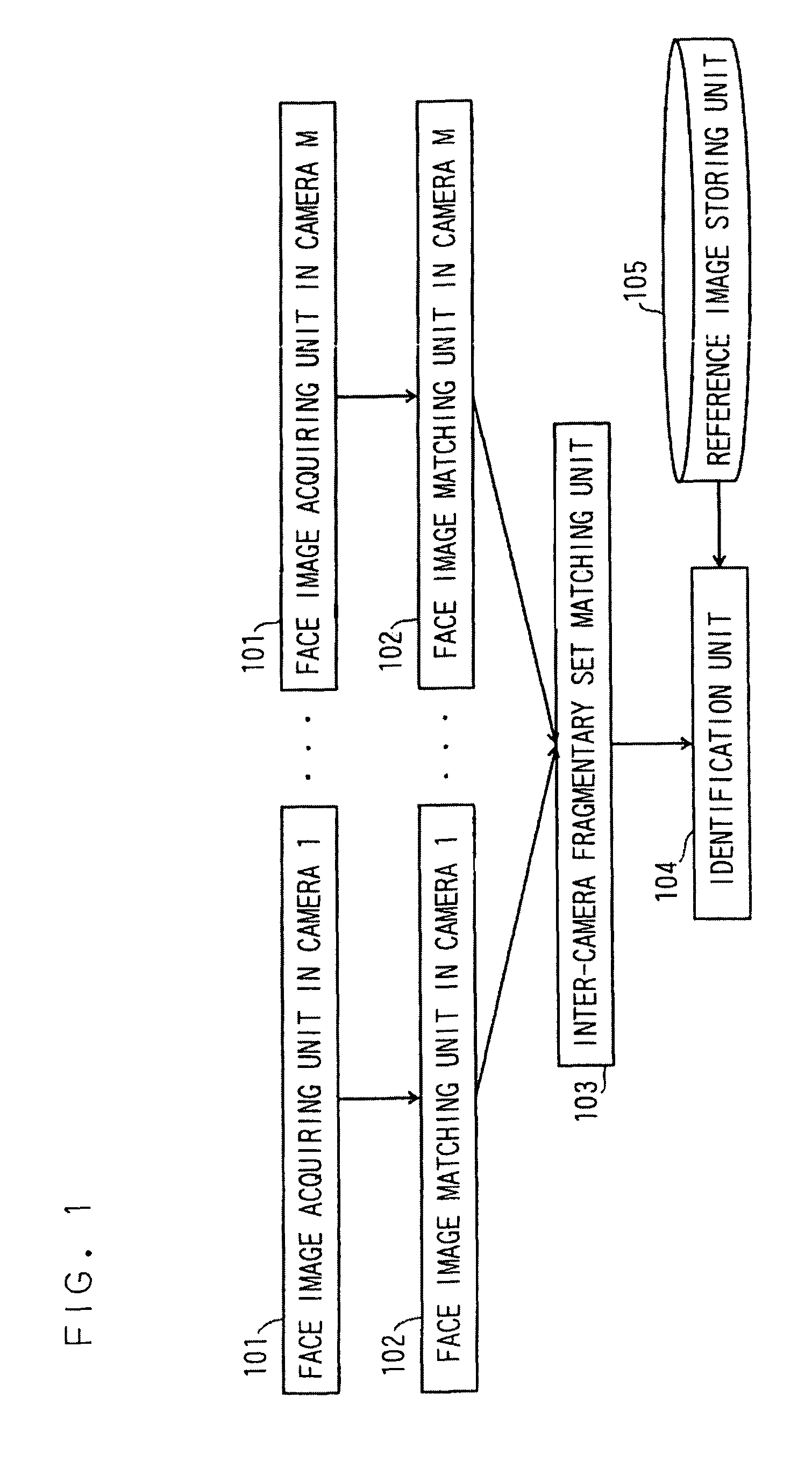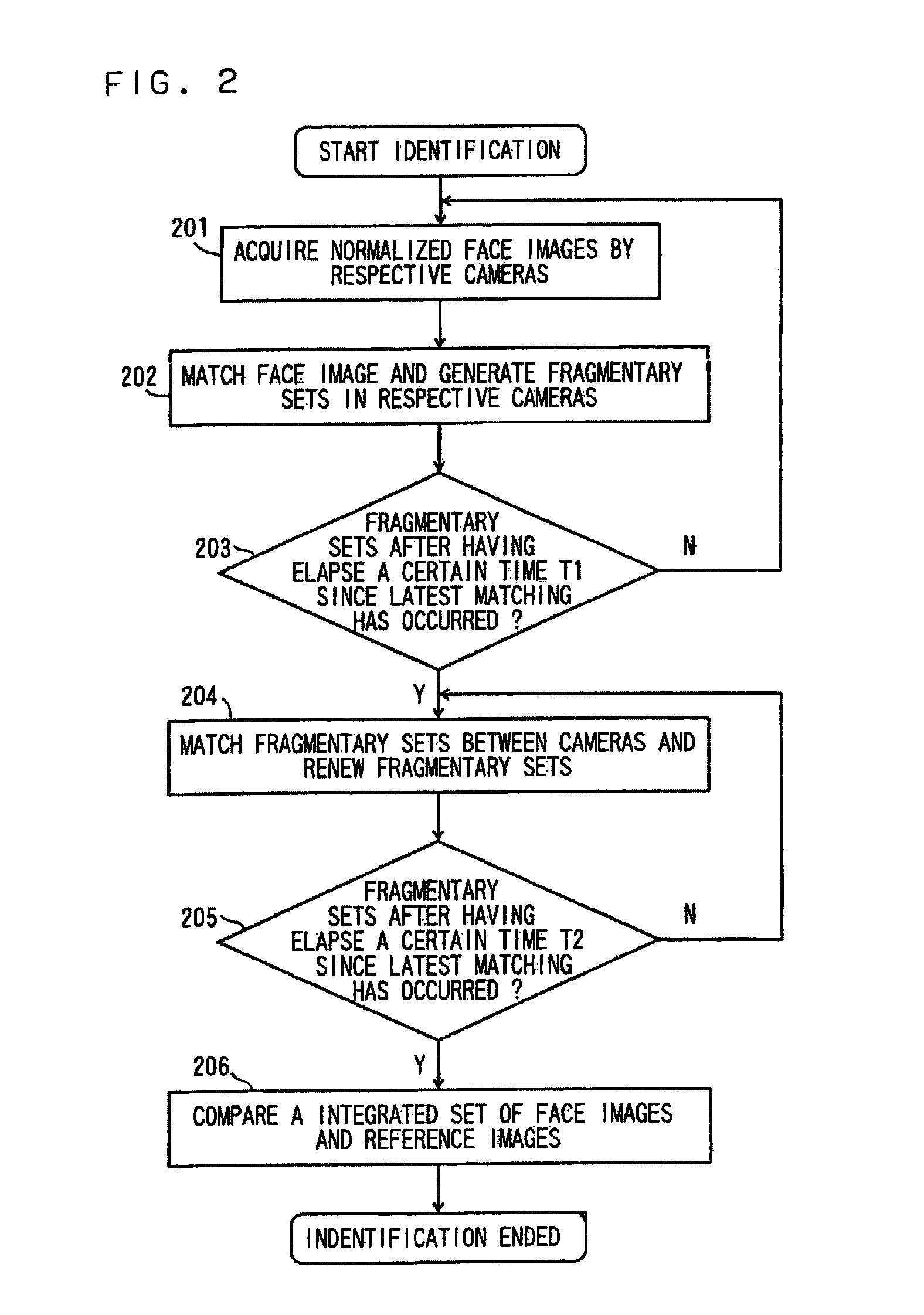Face recognition apparatus and face recognition method
a face recognition and face recognition technology, applied in the field of face recognition apparatus, can solve the problems of difficult occlusion, low frame rate of cameras, and often the best-shot face image cannot be obtained from a single camera, so as to increase the probability of face detection, high correlation, and high recognition performance
- Summary
- Abstract
- Description
- Claims
- Application Information
AI Technical Summary
Benefits of technology
Problems solved by technology
Method used
Image
Examples
first embodiment
[0030]Referring now to FIG. 1 and FIG. 2, a face recognition apparatus 100 according to the first embodiment of the present invention will be described. In the face recognition apparatus 100 according to the first embodiment, a plurality of (for example, three) cameras are installed in a corridor as shown in FIG. 6 for monitoring one position by these cameras. When moving people (for example, one man and one woman) go through this monitored area, identification of these moving people is performed. Face images from three cameras are matched for the respective persons in the cameras, and generate respective fragmentary sets as shown in (1) in FIG. 7. Subsequently, the fragmentary sets are matched between the cameras as shown in (2) in FIG. 7. Finally, the identification is performed as shown in (3) in FIG. 7.
(1) Configuration of Face Recognition Apparatus 100
[0031]FIG. 1 shows a configuration of the face recognition apparatus 100.
[0032]The face recognition apparatus 100 includes a fac...
second embodiment
[0050]Referring now to FIG. 3, a face recognition apparatus 300 according to the second embodiment of the present invention will be described. In this embodiment, an apparatus in which a process of matching the fragmentary sets in the respective cameras is added to the first embodiment is provided. There is a case in which some fragmentary sets are generated in the identical camera although the sets are generated from the identical person because the matching is failed by being affected by variations. In order to prevent occurrence of such event, the fragmentary sets are matched in the cameras before the matching between the cameras.
[0051]FIG. 3 shows a configuration of the face recognition apparatus 300.
[0052]The face recognition apparatus 300 includes a face image acquiring unit 301, an in-camera face image matching unit 302, an in-camera fragmental set matching unit 303, an inter-camera fragmentary set matching unit 304, an identification unit 305, and a reference image storing u...
third embodiment
[0056]Subsequently, referring now to FIG. 4, a face recognition apparatus 400 according to the third embodiment of the present invention will be described. In this embodiment, an apparatus in which a process of extracting person attributes such as gender is added to the first embodiment is provided. An object of this process is to record histories which indicate attributes of the persons (such as gender and age) when people moves whose face images are not registered in the system as reference data.
[0057]FIG. 4 shows a configuration of the face recognition apparatus 400.
[0058]The face recognition apparatus 400 includes a face image acquiring unit 401, an in-camera face image matching unit 402, an inter-camera fragmentary set matching unit 403, an identification unit 404, a reference image storing unit 405, an attribution determining unit 406, and a person attribute searching unit 407.
[0059]The face image acquiring unit 401 performs the same process as the face image acquiring unit 10...
PUM
 Login to View More
Login to View More Abstract
Description
Claims
Application Information
 Login to View More
Login to View More - R&D
- Intellectual Property
- Life Sciences
- Materials
- Tech Scout
- Unparalleled Data Quality
- Higher Quality Content
- 60% Fewer Hallucinations
Browse by: Latest US Patents, China's latest patents, Technical Efficacy Thesaurus, Application Domain, Technology Topic, Popular Technical Reports.
© 2025 PatSnap. All rights reserved.Legal|Privacy policy|Modern Slavery Act Transparency Statement|Sitemap|About US| Contact US: help@patsnap.com



